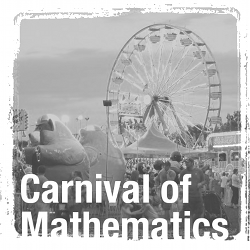Welcome to the 207th Carnival of Mathematics!

I’d like to introduce you to the number 207. It looks as though it could be prime, but it isn’t. Its prime factorisation is $3^2 \times 23$. Thanks to Number.Academy I have a couple of interesting facts about 207, and some questions that I thought of when I read the facts:
- It’s the smallest possible sum of primes formed using each of the digits 1 to 9 exactly once: $2 + 5 + 7 + 43 + 61 + 89 = 207$. (Question: Is it possible to use each of the digits 0 to 9 exactly once to create a sum of primes?)
- It’s the smallest product of three primes that becomes a cube when its central digit is deleted. (Question: Is there a product of three primes that becomes a square when its central digit is deleted?)
I don’t know the answer to either of these questions, and haven’t really thought about them yet. Feel free to write something about them that could be featured in a future carnival. Now onto July’s maths content!
On Instagram, doubleroot has found an interesting and beautiful way to create an ellipse, and invites us to consider why it works.
Over on YouTube, the team at Ganit Charcha have created a video of amazing tricks to play with numbers. The video is part of a series of workshops that are meant to be a fun learning ride for the students, and will help students to understand the basic concepts of mathematics using a method of learning that enhances their ability to think.
Also on YouTube, the channel Mathematical Visual Proofs has created this lovely video containing a variety of proofs that $1+2+3+…+n=\frac{n(n+1)}{2}$ to show how thinking deeply about simple things can lead to a surprising amount of mathematics.
On Twitter, @cakesmyth has written a thread about the links to cryptography in the game Bananagrams. I had never heard of bananagrams before, but it sounds like fun!
Finally, I can’t let July’s carnival slip past without mentioning pi approximation day on 22nd July (otherwise known as $22/7 = 3.14285\dots$). Check out the #PiApproximationDay hashtag on Twitter for lots of approximate pi fun.
That’s all for this month! The next carnival will be hosted by James Arthur. You can find details of all the previous carnivals on The Aperiodical’s carnival page.

Leave a Reply